Content
At the end of the nineties, breeders managed to bring out the frost-resistant apricot Favorit, suitable for growing in the Moscow region. It is distinguished by self-fertility, good taste. The variety is popular among gardeners, it grows successfully in the Moscow region and the Central region of Russia.
Breeding history
The first seedling of the Favorit variety was obtained in 2000. The scientist breeder L.A. Kramarenko is considered the creator of the culture; the Main Botanical Garden is the originator. In 2004, the variety was included in the State Register. The creators recommend growing Favorite apricot in the Moscow region and in the Central region.
Modern breeders have gone further and, based on the Favorit variety, created a new culture - the columnar apricot. The tree is compact in size, its height does not exceed 2.5 m, the length of the shoots reaches 20 cm. The culture is used as a fruit and ornamental plant.
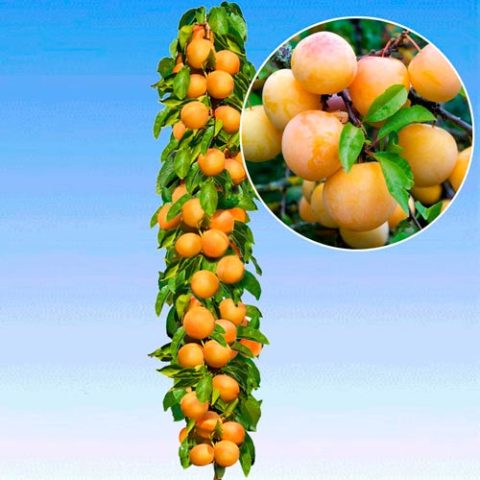
Favorit columnar apricot is a frost-resistant premium variety that tolerates temperatures down to -30 ᵒС
Description of apricot variety Favorite
The tree is notable for its moderate vigor of growth, its height does not exceed 4 m. The crown is not thickened, differs in translucency, the shoots are well ventilated and illuminated. The shape is spreading, slightly raised. Annual shoots, branched.
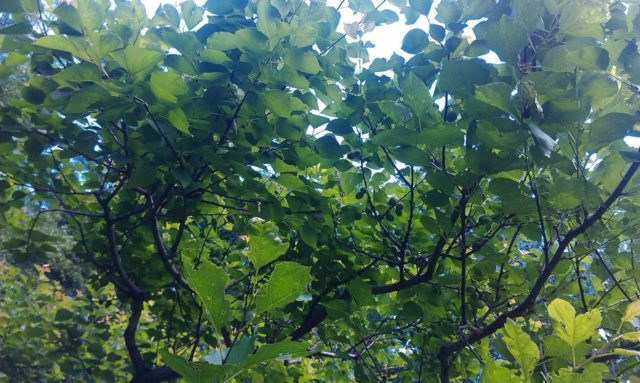
Favorite begins to bear fruit 3-4 years after planting 2-year-old seedlings
During the flowering period, small white buds are formed, the diameter of which does not exceed 3.5 cm. Flowers bloom earlier than leaves appear.
The bark on old trees is brown, grayish, covered with shallow cracks. Young shoots have red-brown bark.
The leaves are oblong, with a pointed tip, ovoid, with jagged edges, dark green in color. Shoots cover sparsely.
As you can see in the photo, the fruits of the Favorit apricot variety are quite large, their average weight is 30 g. The shape is round, the surface is uneven, the skin is covered with soft fluff. The color of the fruit is orange, the barrel is bright red.
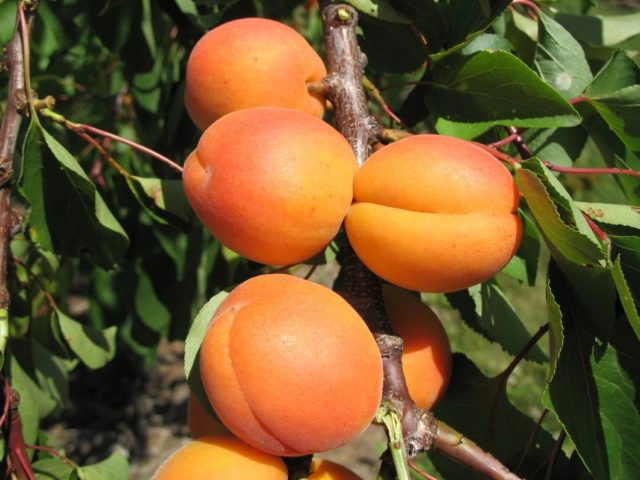
Apricot Favorite belongs to varieties of late ripening
The pulp is bright orange, gristly, dense, but juicy. The stone is small, the volume is about 8% of the total size of the fruit, it is easily separated from the pulp.
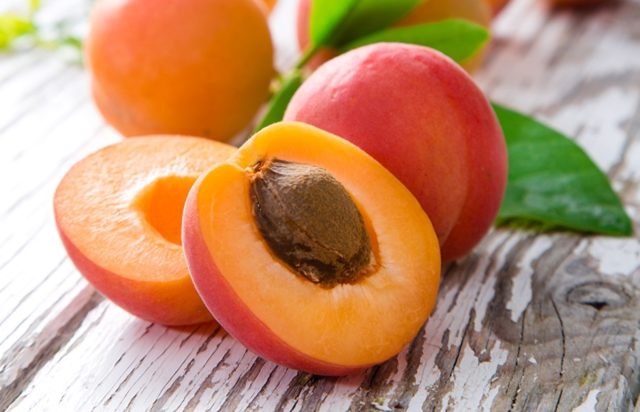
Tasting assessment of the taste of the fruit is 5 points
Characteristics
When choosing a fruit tree for a garden, it is important to consider its main characteristics. The Favorite variety is unpretentious in care, suitable for growing throughout central Russia.
Drought tolerance, winter hardiness
Apricot is a southern crop adapted for cultivation in the Central region, retains its basic qualities and is distinguished by drought resistance. During the period of ovary formation, the tree needs watering to improve the quality of the fruit.
Apricot Favorite is adapted to cold winters, tolerates return frosts well, the kidneys do not suffer from temperature drops. They are able to withstand its decrease to - 15 ᵒС.For the Favorite variety, frosts are dangerous during the flowering period. Only seedlings of the first year need shelter for the winter.
Apricot pollinators Favorite
Before planting, it is important to find out whether this is a self-fertile variety of apricots or not. The favorite does not require pollinators, since it belongs to the first crop option. This is important for regions with short, cool summers.
To increase yields, improve the quality of fruits, other varieties are planted next to Favorite that coincide with it in terms of flowering and fruiting: Tsarsky, Monastyrsky, Lel.
Flowering period and ripening time
Apricot Favorite begins to bloom in May. The first crop is harvested at the end of August. During the short, cold summer, the fruits may not ripen until the first cold weather.
Productivity, fruiting
Apricot Favorite is not very productive. From one adult tree, you can get no more than 20 kg of fruit.
The variety begins to bear fruit 4 years after planting, be sure to vaccinate.
Scope of the fruit
Apricots Favorit retain their presentation, taste for a long time, and are not damaged during transportation. They are tasty fresh and are also suitable for canning. Delicious preserves, jams, confitures are obtained from the fruits. They are also suitable for drying. Overripe fruits are allowed for processing for the preparation of wines, liqueurs.
Disease and pest resistance
The apricot northern Favorite is resistant to the main pests and diseases of garden trees. But it can suffer from clasterosporium disease, rarely from the attacks of aphids.
Advantages and disadvantages
The variety is adapted to the climatic conditions of the Moscow region and the Central regions of Russia. Initially, the southern culture bears excellent fruit in the conditions of a short, cool summer.
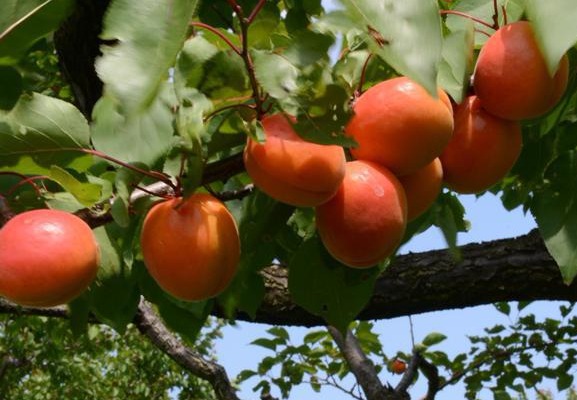
Favorite variety belongs to universal, it can be cultivated in the south.
Advantages:
- early maturity;
- high palatability of fruits;
- preservation of presentation during transportation;
- frost resistance;
- drought resistance;
- bright, appetizing fruit color.
The disadvantages of the variety include low yield and late ripening of fruits.
Landing features
Several seedlings are rooted at a distance of 4 m from each other. In rows, this distance is 5 m.
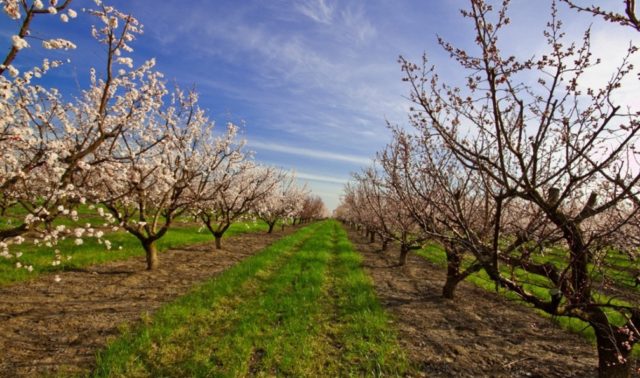
Apricot Favorite grows well, with close planting access of sunlight to the fruits will be difficult
Recommended timing
Apricot Favorite is planted in early spring - this is the end of March or the beginning of April. It is important to choose a time when the buds on the shoots have not yet appeared. Such a tree quickly takes root in a new place, easily adapts to the climatic conditions of the region. Autumn planting is not recommended for culture.
Choosing the right place
Apricot Favorite needs open areas with good access to light and air. Strong winds and drafts should be avoided. It is advisable to plant the crop next to a building or fence, on the south side of the garden. In the lowland, the plant can die from stagnant water, apricot Favorite is rooted on a hill.
What crops can and cannot be planted next to an apricot
On the same site with the Favorite, other varieties are planted, peach. Neighborhood of apricot with apple trees, plums, pears, mountain ash is not recommended. These crops share common diseases and consume the same elements from the soil. The walnut is planted away from fruit trees, as this strong tree clogs everything that grows within a 5 m radius.
Selection and preparation of planting material
Varietal crops are best purchased in a nursery. A 2-year-old tree is chosen, with a well-developed root system, several branched shoots, and a straight, strong trunk.

The survival rate and future harvest depend on the quality of the seedling.
Before planting, dry root shoots are cut off, and the root of a young plant is soaked for 12 hours in a growth stimulator.
Landing algorithm
Young apricot Favorite is rooted according to the rules. Before planting, the soil is dug up, mixed in equal parts with humus.
Procedure:
- A month before the expected landing date, holes are dug. Their depth and diameter should be 70 cm.
- The pit is filled by a third with a nutrient mixture: garden soil, sand, organic matter. All components are taken in equal parts. The soil mixture is spread over a mound.
- The seedling is placed vertically in a pit, the rhizome is laid out on the surface of the mound. The root collar is deepened by 3 cm.
- The root is covered with fluffy earth, lightly tamped it.
- A near-stem circle is formed around the seedling, the plant is watered abundantly.
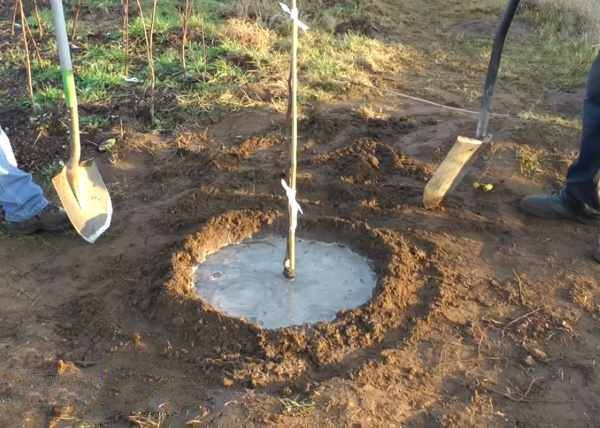
Water helps to shrink the earth, fill all the voids
After watering, the crown is trimmed, shortening the shoots to 60 cm.
Follow-up care of the culture
Apricot Favorite does not tolerate waterlogging. If the summer is hot, the culture is watered 3 times per season, abundantly.
After the first harvest, the tree is fed with organic matter. Fertilizers are applied to the soil during autumn digging.
In the spring, sanitary pruning of the tree is carried out, removing all dry and damaged shoots. In autumn, the crown is formed by shortening and thinning the branches.
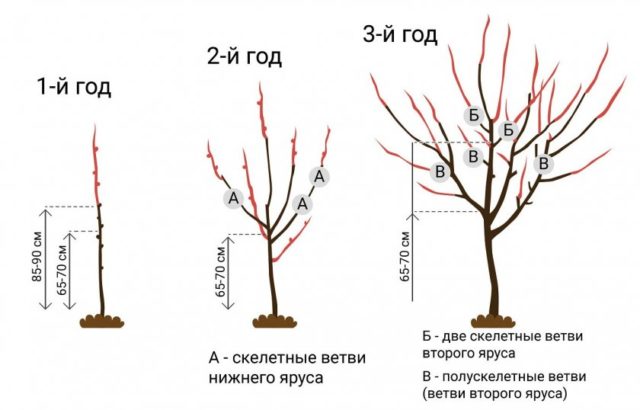
Regular pruning is the best prevention of fungal diseases
Diseases and pests
Apricot Favorite can infect clasterosporium. This is a fungal infection, its other name is perforated spot.

The disease spreads from leaves to fruits, rusty spots appear on apricots
As soon as traces of the disease appear on the leaves, the tree is urgently treated with fungicides.
Aphids are a pest dangerous for apricot Favorite. The insect eats away the soft part of the leaves, weakening the plant, reducing the yield.
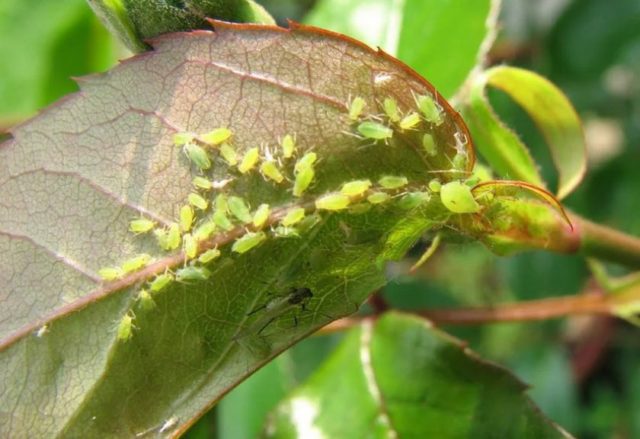
Leaves affected by aphids curl, for this reason spraying without removing the affected areas becomes ineffective
The tree is treated with insecticides according to the instructions. The previously affected leaves are removed.
Conclusion
Apricot Favorit is a southern culture adapted to the conditions of central Russia. The variety is distinguished by drought resistance and frost resistance at the same time. It will not be difficult to grow this culture, caring for it is simple, and the first fruits will delight you with excellent taste.
Reviews of summer residents about the favorite apricot variety
Elena Vasnetsova, 45 years old, Istra








